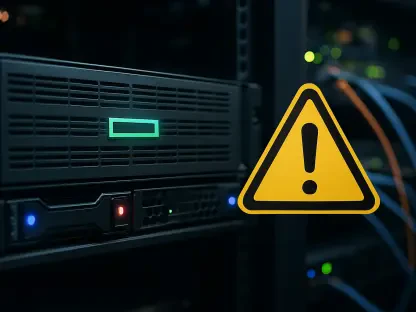In a recent turn of events, cyberattackers have begun utilizing fake Google Meet error messages as part of an elaborate social engineering campaign known as ClickFix. This campaign aims to disseminate info-stealing malware by banking on users’ trust in widely-used platforms like Google Meet. By creating a deceptive yet convincing façade, these threat actors exploit the familiarity and reliance professionals have on such platforms, thereby facilitating the execution of malicious code on users’ systems. This modus operandi highlights a strategic evolution in cyberattack methodologies, making the threat landscape increasingly perilous for both individual and corporate users.
The Emergence of ClickFix: A New Threat Landscape
The sophisticated ClickFix campaign, identified by the French cybersecurity firm Sekoia, repurposes a tactic called ClearFake. Initially discovered in May 2024, ClearFake exploits PowerShell and clipboard functionality to trick users into executing malicious code. Proofpoint, a prominent cybersecurity company, has revealed that this devious tactic has been widely adopted by cybercriminal groups such as the initial access broker TA571. These cybercriminal groups often use ClearFake to deliver various types of malware, including DarkGate, Matanbuchus, NetSupport, and other info-stealers.
One significant aspect of this campaign is its sophistication in mimicking trusted platforms. Sekoia’s research highlights instances where threat actors created websites that closely resemble the homepage of Google Meet video conferences. Deceptive pop-up windows on these fake sites alert users to fictitious problems involving their microphone or headset. Users are then prompted to fix these issues by following instructions that ultimately lead to the unintentional installation of malware. This nuanced manipulation leverages social engineering to make the threat very plausible, increasing the likelihood that users will fall for the scam.
Detailed Analysis and Target Groups
Further analysis by Sekoia linked this cluster of attacks to cybercrime groups identified as “Slavic Nation Empire (SNE)” and “Scamquerteo,” sub-groups of the larger cryptocurrency scam teams “Marko Polo” and “CryptoLove,” respectively. By detailing the domain names and IP addresses associated with these attacks, and providing samples of the URLs used to mimic legitimate Google Meet pages, Sekoia offers a comprehensive view of the technical infrastructure behind the campaign. The campaign has shown increased activity over time, with variations reported, including OneDrive Pastejacking – another method involving clipboard functionality to deliver malicious payloads.
Specifically, Windows and MacOS users are targeted with different malware strains. Windows users are typically infected with Stealc and Rhadamanthys, whereas MacOS users fall victim to AMOS stealer, according to the observed campaign activities. This bifurcation of malware types depending on the operating system indicates a nuanced understanding by attackers of platform-specific vulnerabilities and user behaviors. By employing such a detailed and diverse approach, cybercriminals maximize their potential success rate, continuously adapting their methods to exploit the most susceptible targets.
Ongoing Campaign Activities and Implications
As of September 2024, multiple cybercriminal groups have adopted the ClickFix tactic, leveraging it in diverse ways such as email phishing campaigns, compromised websites, and using established distribution infrastructures. This widespread use underscores the adaptability and rapid iteration of these methods as threat actors refine their approach to increase their chances of success. The resilience of these attacks signals an urgent need for enhanced cybersecurity measures and greater user awareness.
The article suggests that despite the concerning rise in such sophisticated social engineering tactics, a silver lining exists. The attacks’ success depends heavily on user interaction, which presents an opportunity for mitigation through aggressive training and awareness programs. Enterprises can potentially reduce the impact of these threats by educating their staff on how to identify and report suspicious activities effectively. This highlights the importance of continuous user education as a frontline defense against evolving cyber threats.
Broader Cybersecurity Trends and Regulatory Landscape
Related discussions in the article touch upon broader cybersecurity trends, such as the role of generative artificial intelligence (GenAI) in bolstering cybersecurity measures. The potential for GenAI to identify and neutralize threats more swiftly adds a valuable layer to modern cybersecurity strategies. Another highlighted issue is the recent security lapse by Microsoft in collecting critical security logs, which exposed various services like Microsoft Entra, Azure Logic Apps, and Microsoft Sentinel to risks. Such lapses underscore the importance of maintaining stringent security protocols and monitoring mechanisms in the digital age.
The evolving regulatory landscape is also featured prominently, particularly the EU’s NIS2 Directive aimed at enhancing cybersecurity resilience across member states. This directive reflects a trend towards stricter enforcement and extended scopes in cybersecurity regulation, demanding that organizations across a variety of sectors bolster their defenses. The implications of such regulatory changes are far-reaching, necessitating a proactive approach to compliance and security preparedness.
Conclusion
Recently, cyberattackers have turned to using fake Google Meet error messages as part of a sophisticated social engineering scheme known as ClickFix. This nefarious campaign aims to spread info-stealing malware by leveraging users’ trust in platforms like Google Meet. By crafting a deceptive yet believable façade, these cybercriminals exploit the confidence and dependence professionals place in such widely-used services, thereby enabling the execution of harmful code on users’ computers.
This approach marks a significant evolution in cyberattack strategies, making the digital landscape increasingly dangerous for both individuals and businesses. The attackers meticulously design these phony error messages to look authentic, thus luring unsuspecting users into clicking on malicious links or downloading harmful files.
The growing sophistication of such tactics underscores the need for heightened awareness and more robust cybersecurity measures. Organizations and individuals alike should be vigilant, ensuring they verify any unexpected prompts or error messages, especially from platforms they routinely use, to safeguard against such insidious threats.









